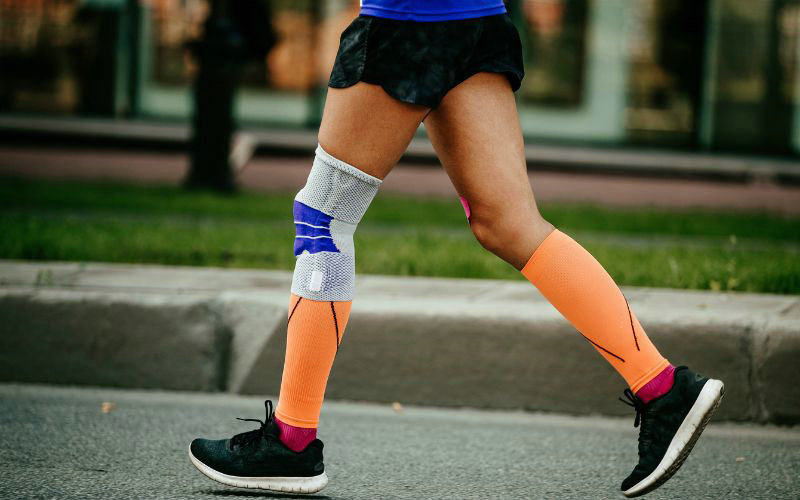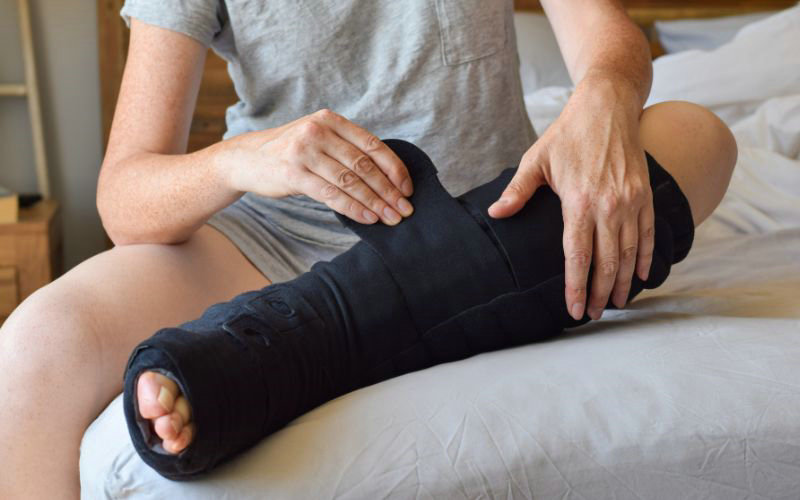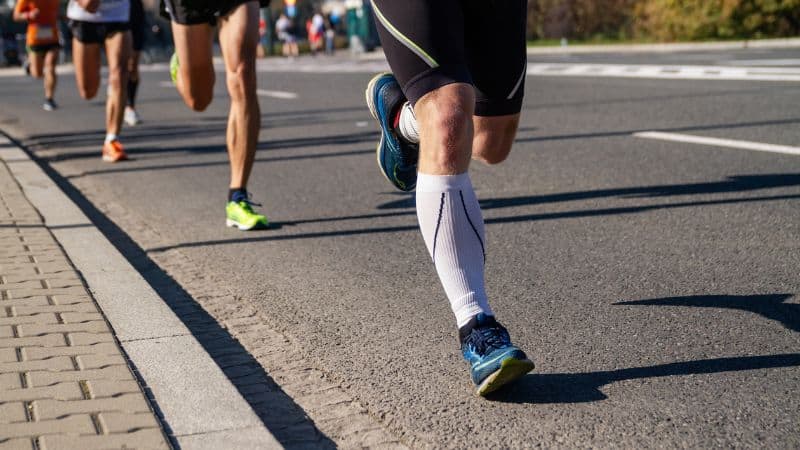
Key Takeaways
- Who Benefits: people with chronic leg swelling, pregnant women, active individuals and workers, individuals with vein-related conditions, and neuropathy patients.
- How They Work: By applying gentle pressure to your legs, compression socks facilitate blood flow toward your heart, enhancing circulation and reducing swelling.
- Potential Uses:
- Improving blood circulation
- Reducing leg swelling
- Easing pain from varicose veins
- Decreasing the risk of blood clots
- Alleviating discomfort for those standing for long hours
- Proper Selection: Choose the correct compression level and size for maximum benefit.
- Side Effects: While typically minimal, potential side effects can include skin irritation or discomfort if compression socks are too tight or worn incorrectly.
Understanding Compression Socks
Compression socks are specialized hosiery designed to prevent the occurrence of, and guard against further progression of, venous disorders such as edema, phlebitis, and thrombosis by applying gentle pressure to your legs and feet. This pressure assists in improving blood flow and can greatly reduce pain and swelling in your legs.
Special Socks that Apply Gentle Pressure to Legs/Feet
These are not your ordinary socks. Compression socks are engineered to deliver uniform compression to your legs and feet, encouraging blood to flow back to your heart and reducing swelling. The material of the socks is crucial, typically a combination of spandex or rubber beside natural fibers, which provides both comfort and the necessary elasticity to create consistent pressure. They come in various compression levels, mainly measured in millimeters of mercury (mmHg).
Graduated Compression and Its Importance
Graduated compression means that the pressure applied by the socks is strongest at the ankles and gradually decreases towards the knees. This gradient helps to combat the effects of gravity and is vital in improving blood circulation, minimizing swelling, and preventing the buildup of fluid in the lower legs. The compression levels can range from light pressure (8-15 mmHg) to strong pressure (30-40 mmHg), with your specific needs determining the appropriate compression level. It’s essential that you select the right grade to ensure maximum benefit and comfort.
Different Types of Compression Stockings
Compression stockings come in various types—each designed for specific needs. The following table will show you different options of compression stockings.
| Type of Compression Stocking | Pressure Distribution | Ideal For | Prescription Required | Additional Features |
| Graduated Compression Stockings | Most pressure at the ankle, gradually decreasing up the leg | Individuals on their feet a lot or with circulation issues | No, but prescription options are available for a tailored fit | Choose between open-toe or closed-toe based on preference and shoe type |
| Anti-embolism Stockings | Uniform pressure distribution | Bedridden patients to prevent Deep Vein Thrombosis (DVT) | Yes, typically prescribed | May come in open-toe or closed-toe options |
| Over-the-Counter Stockings | Varies by product | General use without specific medical indications | No | Available in open-toe or closed-toe designs |
| Prescription Compression Stockings | Customized pressure distribution for targeted therapy | Individuals with specific medical needs requiring a perfect fit | Yes | Customizable features, including toe style |
How do Compression Socks Help with Swelling?

Enhance Blood Circulation
Compression socks apply graduated compression to your legs. This means the pressure is strongest at the ankles and gradually decreases up the leg. This design helps to counteract gravity’s effects on your blood flow, encouraging the return of blood to your heart and reducing the chance of swelling. The material of these socks is elastic and firm, providing a comfortable fit.
Reduce Fluid Buildup
The snug fit provided by the right level of compression can prevent fluid from building up in your lower legs. Even compression, or a consistent level of tightness, significantly reduces the risk of edema or fluid accumulation. By wearing compression socks, you’re helping to maintain a normal fluid balance in your leg tissues.
Provide External Support
Compression socks offer external support to your leg veins, encouraging better blood flow and supporting the muscles and blood vessels. This external pressure provided by the material of the sock is especially beneficial when you’re stationary for extended periods, such as during long flights or when seated at a desk all day. By wearing compression socks, you give your legs the extra support they need to stay healthy and swelling-free.
Who can benefit from compression socks?
Compression socks are a beneficial tool for various groups experiencing leg issues:
- People with Chronic Leg Swelling: If you frequently suffer from leg swelling, compression socks can help by applying pressure and promoting blood flow, reducing the discomfort from swollen legs.
- Pregnant Women: During pregnancy, you might experience increased leg swelling. Compression socks can alleviate some of that swelling by enhancing circulation.
- Active Individuals and Workers: Whether you’re an athlete or spend long hours on your feet, compression socks may reduce soreness and fatigue in your legs by improving blood flow.
- Individuals with Vein-Related Conditions: If you have varicose veins or edema, the support from compression socks can ease discomfort and prevent the worsening of these conditions.
- Neuropathy Patients: Those experiencing neuropathy may find that compression socks stimulate circulation, which could potentially provide relief from neuropathic pain.
Medical and Practical Applications

Compression socks offer significant benefits in both medical settings and everyday practical scenarios. They aid in managing symptoms of various health conditions and enhance comfort during physical activities and long journeys.
Compression Socks in Healthcare
Compression socks are a cornerstone for conditions like deep vein thrombosis (DVT) and varicose veins. Wearing these socks applies graduated pressure to your lower legs, which promotes better venous return and reduces the risk of blood clots. This is particularly important for postoperative patients or individuals with limited mobility. They are also beneficial in the treatment of venous ulcers and may support the lymphatic system in conditions such as lymphedema. If you are dealing with peripheral artery disease, diabetes, or orthostatic hypotension, your healthcare provider might recommend compression socks to improve circulation and provide symptom relief.
Compression Socks for Athletes and Travelers
If you’re an athlete, you might find compression socks useful for exercise recovery. The pressure from these socks can enhance blood flow, thereby helping to reduce lactate accumulation after vigorous sports activities. This leads to a potential decrease in muscle soreness and faster recovery times. For travelers, especially those embarking on long flights or car rides, compression socks can minimize the discomfort and swelling associated with prolonged periods of inactivity. They help maintain circulation and prevent DVT, a risk associated with long-duration traveling. Whether you’re a marathon runner or a frequent flyer, compression socks could be your ally for added relief and well-being during and after your activities.
Selecting the Right Compression Socks
Choosing the Correct Length and Size
Knee-high compression stockings are widely used because they are easier to put on and are suitable if your swelling is confined to the lower legs. For more comprehensive coverage, thigh-high compression stockings or those that extend to the waist can help manage swelling in the entire leg. In terms of size, it’s crucial to measure your legs at the widest points, typically around the ankle and the thigh. Replace your compression stockings every 3-6 months or as recommended to maintain the correct level of compression.
Usage and Care Instructions
Compression socks are a valuable tool for managing swelling and improving circulation, particularly if you are required to stand or sit for extended periods, or following surgery. The efficacy and longevity of your compression stockings largely depend on how they are worn and cared for. Below are some specific guidelines to help you get the most out of these medical-grade garments.
Proper Ways to Wear and Remove
To ensure your compression socks work effectively and do not cause skin irritation, such as itching or discomfort from ill-fitting stockings, follow these steps:
- Morning Routine: Put on your compression socks first thing in the morning when swelling is minimal.
- Smooth Application: Ensure that the socks are smooth against your skin without any wrinkles or bunches.
- Application Tips: Avoid using lotion before application as it can make it difficult to put on the socks and may degrade the fabric.
To Remove Compression Socks:
- Gently roll the stocking down your leg.
- Do not pull from the top band to avoid overstretching the fabric.
Maintenance and Replacement Guidelines
The care of your compression socks is essential for their performance and durability:
- Washing: Wash the stockings daily to remove the buildup of oils and skin cells, which can degrade the elastic fibers. Use mild soap and cool water, then air dry.
- Breathability: Look for breathable materials when obtaining new stockings to help manage moisture and heat.
- Replacement Timeline: Replace your compression socks every three to six months, depending on their use and wear.
- Inspect for Damage: Regularly check your socks for signs of wear, such as thinning or holes, as this indicates a need for replacement.
By adhering to these usage and care instructions, your compression socks will remain effective and comfortable, helping reduce your swelling and improve your blood circulation efficiently.
Frequently Asked Questions
What are the potential side effects of long-term compression stocking usage?
Over extended periods, using compression stockings might lead to skin irritation or breakdown, especially if they are not fitted properly or if you have sensitive skin. Ensuring a correct fit and regular skin assessments are crucial to mitigate these risks.
For optimal effectiveness, how long should one wear compression socks to alleviate foot swelling?
To reduce foot swelling, it’s often recommended to wear compression socks throughout the day, especially during long periods of sitting or standing. Remove them before sleeping, unless your healthcare provider advises otherwise.
Under which circumstances is wearing compression stockings ill-advised?
You should avoid compression stockings if you have certain conditions such as peripheral neuropathy, peripheral artery disease, or skin infections. Consult with your doctor to determine if compression stockings are safe for you.
After putting on compression socks, how quickly can one anticipate a reduction in swelling?
Some individuals may notice a reduction in swelling within a few hours of wearing compression socks. While for others, it may take several days to observe the benefits. Continual use generally provides better results.
Are there specific benefits to wearing compression socks during physical activity or walking?
Wearing compression socks during physical activity can improve blood circulation, reduce muscle fatigue, and help prevent swelling in the lower limbs.
Which types of compression socks are most effective for managing and reducing swelling?
Graduated compression socks, which provide stronger pressure at the ankles and gradually decrease upward, are considered most effective for managing and reducing swelling in the legs.



